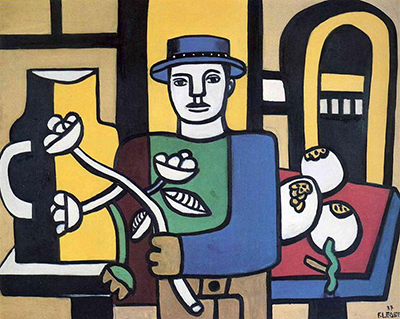Completed in 1937, The Man in the Blue Hat is one of Fernand Léger’s pieces in the purism style. The period followed cubism, after WWI. Experts considered it a return to the pre-war cultural and social forces. Léger had a reputation for taking an art technique and paving his path.
This French artist did the same with purism. The principle behind this art form is the creation of pure features without the burden of representational meaning. The Man in the Blue Hat is one of the simplest artworks from Léger. This statement does not imply that the technique is plain, but there isn't much going on in the scene. The piece features a man who looks to be standing in front of a house. He is wearing a multi-coloured shirt, brown trousers and of course, a blue hat. The subject is holding a long-stemmed flower that has full leaves sprouting from its branches.Next to him is a disproportionately large flower pot. It seems as if the man wants to put freshly cut flowers into the container. On his opposite side, a short distance behind the main subject is a bench with a few other flowers on it. True to the nature of purism, there is no hidden meaning in this painting. The man has a peaceful look on his face, concentrating on the task at hand.
It seems like a mundane task of picking flowers from an outdoor garden. When it comes to colour, this Léger represents the true vision of the artist. Léger had an avid interest in primary colours and used different hues to add depth to his paintings. The Man in the Blue Hat incorporates yellow and white in a big way. Most of the background is in yellow, with white and black contours providing a stunning contrast. One section of the wall behind the man is a light brown, which complements the bright yellow perfectly. The flowers are white with some green on the branches while two petals on the red and blue bench have a hint of yellow, which could be the pollen. The table where the vase is sitting has a white top surface and black legs. As for the subject, his shirt has the colours blue, brown and green that match the hat, trousers and flower branch respectively. This meticulous use of shades gives the scene some personality; it's vibrant without being distracting. Purism emphasises the use of colour to unify the geometric shapes that characterise the movement.
In this painting, Léger simplified the subject while maintaining a classic and beautiful piece. He reaches a balance between realism and abstraction, where everything can be identified, even though it has been reduced to the simplest of forms. This is perhaps a popular approach, where one can appreciate a contemporary style whilst still having a scene to enjoy, where as some of his other works went further into the depths of abstraction to the point where very little can actually be understood and an entirely new world is created from that. Many artists have gone on similar journeys where they slowly progress over time, moving from the traditional styles that they were taught as young students and slowly incorporating abstract ideas over time, before eventually their work is reduced down to simple arrangements of shapes and lines. Good examples of this can be found in the careers of Miro, Mondrian and Kandinsky, all of whom are considered some of the finest exponents of contemporary art from the early to mid 20th century.




